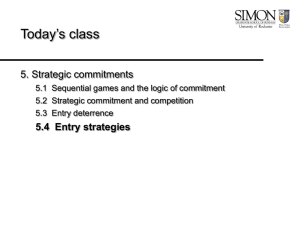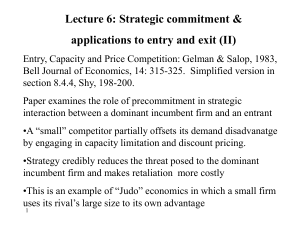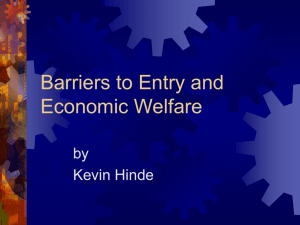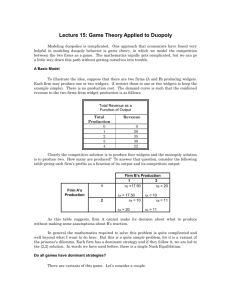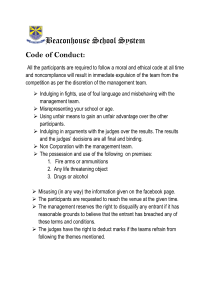ECON 101 Tutorial: Week 1
advertisement
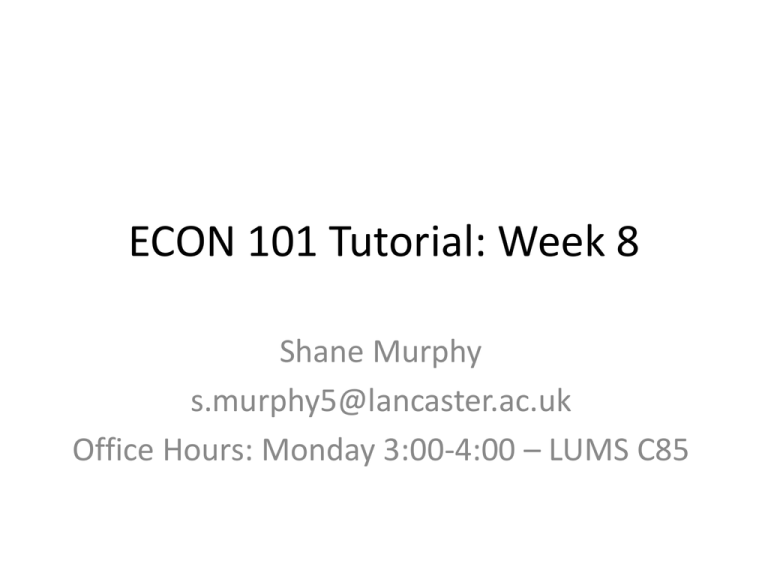
ECON 101 Tutorial: Week 8 Shane Murphy s.murphy5@lancaster.ac.uk Office Hours: Monday 3:00-4:00 – LUMS C85 LUMS Maths and Stats Help (MASH) Centre Are you mystified by maths? Stuck with statistics? The LUMS Maths and Stats Help (MASH) Centre for LUMS undergraduate students opens this week. Every Monday (16.0018.00) and Friday (10.00-12.00), you can drop-in to LUMS B38a or book an appointment to see a student mentor and get help with maths and stats Outline • • • • Roll Call Bonus Problems Discussion Bonus • Box of Lies – – – – – – – – – Melissa McCarthy Emma Stone Kate Hudson Channing Tatum Tina Fey Jennifer Lawrence Julie Bowen Kerry Washington Kate Hudson • You pick Exercise 1 “If a player has a dominant strategy in a simultaneous-move game, then she is sure to get her best possible outcome”. True or false? Explain and give an example of a game that illustrates your answer. False. The Prisoner’s Dilemma is a counter example. Exercise 2 Consider the following simultaneous game: Player A\B Up Down Left 3, 3 2, 2 Right 5, 1 4, 4 • Find the Nash equilibrium or equilibria. – A – up; B – left • Which player, if any, has a dominant strategy? – A – up; B – none • Write down the extensive form for this game, played with simultaneous moves. • Suppose the game is now sequential move, with A moving first and then B. Write down the extensive form for this sequential move game. • Write down the normal form for the sequential move game. Find all the Nash equilibria. Exercise 2 Consider the following simultaneous game: Write down the normal form for the sequential move game. Find all the Nash equilibria. Player A\B Left|Up; Left|Down Left|Up; Right|Down Right|Up; Left|Down Right|Up; Right|Down Up Down 3, 3 2, 2 3,3 4,4 5, 1 4, 4 5,1 4,4 There are 2 Nash Equilibria: • A Up and B Left Up, Left Dawn • A Down and B Left Up, Right Down – This is also a subgame perfect equilibrium Exercise 3 Two classmates A and B are assigned a group project. Each student can choose to Shirk or Work. If one or more players choose Work, the project is completed and gives each student some credit valued at 4 payoff units each. The cost of completing the project is that 6 total units of effort (measured in payoff units) are divided equally among all the players who choose to Work and this is subtracted from their payoffs. If both Shirk, they do not have to expend any effort but the project is not completed, giving each a payoff of 0. The teacher can only tell whether the project is completed and not which students contributed to it Player A\B Shirk Work • Find the NE – Both Shirk Shirk Work 0,0 -2,4 4,2 1,1 • Find the Dominant Strategy, what game is this similar to? – Shirk for both: This is equivalent to the PD Exercise 3 Two classmates A and B are assigned a group project. Each student can choose to Shirk or Work. If one or more players choose Work, the project is completed and gives each student some credit valued at 4 payoff units each. The cost of completing the project is that 6 total units of effort (measured in payoff units) are divided equally among all the players who choose to Work and this is subtracted from their payoffs. If both Shirk, they do not have to expend any effort but the project is not completed, giving each a payoff of 0. The teacher can only tell whether the project is completed and not which students contributed to it Player A\B Shirk Work • Find the NE – Both Shirk Shirk Work 0,0 -2,4 4,2 1,1 • Find the Dominant Strategy, what game is this similar to? – Shirk for both: This is equivalent to the PD Exercise 4 Verify the following game is a version of the Prisoner’s Dilemma Player A\B Confess Silent Confess 0, 0 3, -1 Silent -1, 3 1, 1 Exercise 5 I’m not comfortable teaching this, luckily we are low on time and can skip it. Exercise 6 Identify Nash equilibria in pure strategies (if any) and explain your findings. In particular, consider whether players know which (if any) Nash equilibrium will result. Firm 2\Firm 1 Do not enter Enter Do not enter 0, 0 0, 1 Enter 1, 0 -1, -1 Two NE: Firm 1 Enters, Firm 2 does not Firm 2 Enters, Firm 1 does not Without collusion, we don’t really expect either to occur. Exercise 7 a) Belgium has few traffic signs or signals and does not have a give-way rule. A driver in Belgium who stops to look both ways at an intersection loses the legal right to go first. Using the Game of Chicken, explain why Belgium has more per capita accidents at unmarked intersections resulting in bodily injury compared to neighbouring countries which have more stop signs and traffic lights and explicit rules about right of way. What?!? In America we have stoplights. This question is crazy b) When a man and a woman approach a door at the same time, it is customary for the man to let the woman go first. Use the Game of Chicken to explain this social convention. What?!? I don’t see gender. I only see souls. Exercise 8 BA\Air France QB =96 64 QA = 96 64 48 0, 0 3.1, 2 4.6, 2.3 2, 3.1 4.1, 4.1 5.1, 3.8 Above is the48normal-form representation of a game British and Air 2.3, 4.6 3.8, between 5.1 4.6,Airways 4.6 France where each chooses between three possible actions: fly 96, 64 or 48 thousand passengers between Manchester and Paris, with payoffs as £m profits per quarter. a) Is there a strictly dominant strategy for this game? No. b) c) Use iterated elimination of strictly dominated strategies to find an outcome for the game AF’s QA=96 is strictly dominated by QA = 64 BA’s QB = 96 is strictly dominated by QB = 64 From what remains, 48 is dominated by 64 for each firm. So the equilibrium is QA = QB = 64 List the assumptions you made to discover the game outcome. The iterated approach relies on: • • • • the belief that players won’t choose strictly dominated strategies. Players possess common knowledge that they are payoff maximising Players know that other players are payoff maximizing etc Exercise 9 The entrant moves first and the incumbent observes the entrant’s decision. The entrant can choose to either enter the market or remain out of the market. If the entrant remains out of the market then the game ends and the entrant receives a payoff of 0 while the incumbent receives a payoff of 2. If the entrant chooses to enter the market then the incumbent gets to make a choice. The incumbent chooses between fighting entry or accommodating entry. If the incumbent fights the entrant receives a payoff of -3 while the incumbent receives a payoff of -1. If the incumbent accommodates the entrant receives a payoff of 2 while the incumbent receives a payoff of 1. Solve this game. Exercise 9 The entrant moves first and the incumbent observes the entrant’s decision. The entrant can choose to either enter the market or remain out of the market. If the entrant remains out of the market then the game ends and the entrant receives a payoff of 0 while the incumbent receives a payoff of 2. If the entrant chooses to enter the market then the incumbent gets to make a choice. The incumbent chooses between fighting entry or accommodating entry. If the incumbent fights the entrant receives a payoff of -3 while the incumbent receives a payoff of -1. If the incumbent accommodates the entrant receives a payoff of 2 while the incumbent receives a payoff of 1. Solve this game. Entrant Enter Don’t Enter Incumbent I: 2, E: 0 Fight I: -1, E: -3 Accomodate I: 1, E: 2 Exercise 9 The entrant moves first and the incumbent observes the entrant’s decision. The entrant can choose to either enter the market or remain out of the market. If the entrant remains out of the market then the game ends and the entrant receives a payoff of 0 while the incumbent receives a payoff of 2. If the entrant chooses to enter the market then the incumbent gets to make a choice. The incumbent chooses between fighting entry or accommodating entry. If the incumbent fights the entrant receives a payoff of -3 while the incumbent receives a payoff of -1. If the incumbent accommodates the entrant receives a payoff of 2 while the incumbent receives a payoff of 1. Solve this game. Entrant Enter Don’t Enter Incumbent I: 2, E: 0 Fight I: -1, E: -3 Accomodate I: 1, E: 2 Exercise 9 The entrant moves first and the incumbent observes the entrant’s decision. The entrant can choose to either enter the market or remain out of the market. If the entrant remains out of the market then the game ends and the entrant receives a payoff of 0 while the incumbent receives a payoff of 2. If the entrant chooses to enter the market then the incumbent gets to make a choice. The incumbent chooses between fighting entry or accommodating entry. If the incumbent fights the entrant receives a payoff of -3 while the incumbent receives a payoff of -1. If the incumbent accommodates the entrant receives a payoff of 2 while the incumbent receives a payoff of 1. Solve this game. Entrant Enter Don’t Enter Incumbent I: 2, E: 0 Fight I: -1, E: -3 Accomodate I: 1, E: 2 Discussion • Box of Lies – Melissa McCarthy – Emma Stone – Kate Hudson – Channing Tatum – Tina Fey – Jennifer Lawrence – Julie Bowen – Kerry Washington – Kate Hudson • You pick again!
